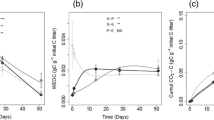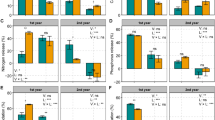Abstract
Litter decomposition is a key process controlling carbon (C) sequestration in Sphagnum dominated peatlands. Peatland drainage lowers the water table, increases vascular plant richness, and alters species evenness. We hypothesized that abiotic and biotic changes following peatland drainage would greatly accelerate litter decomposition. This hypothesis was tested by a litter decomposition experiment in an undrained and a drained area of a peatland which was partially drained 30 years ago. Litter bags filled with shoots of the peat moss Sphagnum magellanicum and leaves of the dwarf shrub Potentilla fruticosa as single species and species mixtures with three evenness treatments were placed at the surface of the peatland. After 6 months (from August onwards) of decomposition, the single species litter of Potentilla fruticosa, with low initial C/N ratio, decomposed much faster than S. magellanicum litter, with high initial C/N ratio in both undrained and drained areas. Overall, mixed litter produced antagonistic effects (observed values less than expected) on decomposition and C/N ratio. Litter mixtures dominated by S. magellanicum showed lower mass loss than other mixtures. Contrary to our expectation, the undrained area showed higher decomposition than the drained area. Our study suggests that drainage-induced alteration in plant diversity slows down litter decomposition in a short term. However, in drained peatlands, lower C/N ratio of mixed litter may enhance decomposition and reduce C sequestration over time.




Similar content being viewed by others
Data availability
All data generated or analyzed during this study are included in this article.
References
Aerts R (1997) Climate, leaf litter chemistry and leaf litter decomposition in terrestrial ecosystems: a triangular relationship. Oikos 79:439–449
Ayres E, Steltzer H, Simmons BL et al (2009) Home-field advantage accelerates leaf litter decomposition in forests. Soil Biol Biochem 41:606–610
Bonanomi G, Incerti G, Antignani V, Capodilupo M, Mazzoleni S (2010) Decomposition and nutrient dynamics in mixed litter of Mediterranean species. Plant Soil 331:481–496
Chen Y, Ma S, Jiang H, Yangzom D, Cheng G, Lu X (2021) Decomposition time, chemical traits and climatic factors determine litter-mixing effects on decomposition in an alpine steppe ecosystem in Northern Tibet. Plant Soil 459:23–35
Dickson TL, Wilsey BJ (2009) Biodiversity and tallgrass prairie decomposition: the relative importance of species identity, evenness, richness, and micro-topography. Plant Ecol 201:639–649
Dimitrakopoulos PG (2010) Influence of evenness on the litter-species richness-decomposition relationship in Mediterranean grasslands. J Plant Ecol 3:71–78
Fenner N, Freeman C, Reynolds B (2005) Hydrological effects on the diversity of phenolic degrading bacteria in a peatland: implications for carbon cycling. Soil Biol Biochem 37:1277–1287
Fenner N, Freeman C (2011) Drought-induced carbon loss in peatlands. Nat Geosci 4:895–900
Fenner N, Freeman C (2020) Woody litter protects peat carbon stocks during drought. Nat Clim Chang 10:363–369
Finerty GE, de Bello F, Bílá K et al (2016) Exotic or not, leaf trait dissimilarity modulates the effect of dominant species on mixed litter decomposition. J Ecol 104:1400–1409
Freeman C, Ostle N, Kang H (2001) An enzymic ‘latch’ on a global carbon store. Nature 409:149
Freeman C, Fenner N, Shirsat AH (2012) Peatland geoengineering: an alternative approach to terrestrial carbon sequestration. Philos Trans A Math Phys Eng Sci 370:4404–4421
Gartner TB, Cardon ZG (2004) Decomposition dynamics in mixed-species leaf litter. Oikos 104:230–246
Gessner MO, Swan CM, Dang CK, McKie BG, Bardgett RD, Wall DH, Hättenschwiler S (2010) Diversity meets decomposition. Trends Ecol Evol 25:372–380
Gogo S, Laggoun-Défarge F, Merzouki F et al (2015) In situ and laboratory non-additive litter mixture effect on C dynamics of Sphagnum rubellum and Molinia caerulea litters. J Soils Sediments 16:13–27
Hájek T, Ballance S, Limpens J, Zijlstra M, Verhoeven JTA (2011) Cell-wall polysaccharides play an important role in decay resistance of Sphagnum and actively depressed decomposition in vitro. Biogeochemistry 103:45–57
Hättenschwiler S, Tiunov AV, Scheu S (2005) Biodiversity and litter decomposition in terrestrial ecosystems. Annu Rev Ecol Evol Syst 36:191–218
Hillebrand H, Bennett DM, Cadotte MW (2008) Consequences of dominance: a review of evenness effects on local and regional ecosystem processes. Ecology 89:1510–1520
Hoorens B, Aerts R, Stroetenga M (2002) Litter quality and interactive effects in litter mixtures: more negative interactions under elevated CO2? J Ecol 90:1009–1016
Hoorens B, Aerts R, Stroetenga M (2003) Does initial litter chemistry explain litter mixture effects on decomposition? Oecologia 137:578–586
Johnson LC, Damman AWH (1991) Species-controlled Sphagnum decay on a south Swedish raised bog. Oikos 61:234–242
Kominoski JS, Pringle CM, Ball BA, Bradford MA, Coleman DC, Hall DB, Hunter MD (2007) Non additive effects of leaf litter species diversity on breakdown dynamics in a detritus-based stream. Ecology 88:1167–1176
Krab EJ, Berg MP, Aerts R, van Logtestijn RSP, Cornelissen JHC (2013) Vascular plant litter input in subarctic peat bogs changes Collembola diets and decomposition patterns. Soil Biol Biochem 63:106–115
Laiho R, Laine J, Trettin CC, Finér L (2004) Scots pine litter decomposition along drainage succession and soil nutrient gradients in peatland forests, and the effects of inter-annual weather variation. Soil Biol Biochem 36:1095–1109
Leroy F, Gogo S, Buttler A, Bragazza L, Laggoun-Défarge F (2018) Litter decomposition in peatlands is promoted by mixed plants. J Soils Sediments 18:739–749
Lecerf A, Risnoveanu G, Popescu C, Gessner MO, Chauvet E (2007) Decomposition of diverse litter mixtures in streams. Ecology 88:219–227
Li D, Peng S, Chen B (2013) The effects of leaf litter evenness on decomposition depend on which plant functional group is dominant. Plant Soil 365:255–266
Liu C, Bu Z-J, Mallik A, Rochefort L, Hu X-F, Yu Z (2020) Resource competition and allelopathy in two peat mosses: implication for niche differentiation. Plant Soil 446:229–242
Mao B, Yu Z-Y, Zeng D-H (2015) Non-additive effects of species mixing on litter mass loss and chemical properties in a Mongolian pine plantation of Northeast China. Plant Soil 396:339–351
Moore TR, Bubier JL, Bledzki L (2007) Litter decomposition in temperate peatland ecosystems: the effect of substrate and site. Ecosystems 10:949–963
Mpamah PA, Taipale S, Rissanen AJ, Biasi C, Nykänen HK (2017) The impact of long-term water level draw-down on microbial biomass: a comparative study from two peatland sites with different nutrient status. Eur J Soil Biol 80:59–68
Naeem I, Asif T, Wu X, Hassan N, Yiming L, Wang H, Wang L, Wang D (2021) Species diversity induces idiosyncratic effects on litter decomposition in a degraded meadow steppe. Front Environ Sci 9:582409
Philben M, Ziegler SE, Edwards KA, Kahler R III, Benner R (2016) Soil organic nitrogen cycling increases with temperature and precipitation along a boreal forest latitudinal transect. Biogeochemistry 127:397–410
Rydin H, Jeglum JK (2013) The biology of peatlands, 2nd edn. Oxford University Press, Oxford
Salamanca EF, Kaneko N, Katagiri S (1998) Effects of leaf litter mixtures on the decomposition of Quercus serrata and Pinus densiflora using field and laboratory microcosm methods. Ecol Eng 10:53–73
Steinwandter M, Schlick-Steiner BC, Steiner FM, Seeber J (2019) One plus one is greater than two: mixing litter types accelerates decomposition of low-quality alpine dwarf shrub litter. Plant Soil 438:405–419
van Breemen N (1995) How Sphagnum bogs down other plants. Trends Ecol Evol 10:270–275
Ward SE, Ostle NJ, McNamara NP, Bardgett RD (2010) Litter evenness influences short-term peatland decomposition processes. Oecologia 164:511–520
Wardle DA, Nilsson M-C, Zackrisson O, Gallet C (2003) Determinants of litter mixing effects in a Swedish boreal forest. Soil Biol Biochem 35:827–835
Wetzel RG (1992) Gradient-dominated ecosystems: sources and regulatory functions of dissolved organic matter in freshwater ecosystems. Hydrobiologia 229:181–198
Yu Z, Loisel J, Brosseau DP, Beilman DW, Hunt SJ (2010) Global peatland dynamics since the Last Glacial Maximum. Geophys Res Lett 37:L13402
Acknowledgements
This study was funded by the National Natural Science Foundation of China (No. 41871046 and 41471043), Jilin Provincial Science and Technology Development Project (No. 20180101002JC and 20190101025JH), and Jilin Provincial Field Observation Station of Changbai Mountain Wetland Ecology (Grant No. 20190901001JC). We thank Zicheng Yu for his help in the field work, Sebastian Sundberg for his help in language edition and three anonymous reviewers for their important comments and suggestions.
Author information
Authors and Affiliations
Contributions
ZJB-conceived and designed the experiment. TA and IN participated in field work and analyzed the data. TA, AM, ZJB, and LR wrote and revised the manuscript.
Corresponding author
Ethics declarations
Conflict of interest
The authors of this study do not have any conflict of interest or competing interests.
Consent for publication
All authors consent for the manuscript to be published.
Additional information
Publisher's Note
Springer Nature remains neutral with regard to jurisdictional claims in published maps and institutional affiliations.
Supplementary Information
Below is the link to the electronic supplementary material.
Rights and permissions
About this article
Cite this article
Asif, T., Naeem, I., Bu, ZJ. et al. Litter mixing effects on decomposition in a peatland partially drained 30 years ago. Wetlands Ecol Manage 29, 883–895 (2021). https://doi.org/10.1007/s11273-021-09818-4
Received:
Accepted:
Published:
Issue Date:
DOI: https://doi.org/10.1007/s11273-021-09818-4




